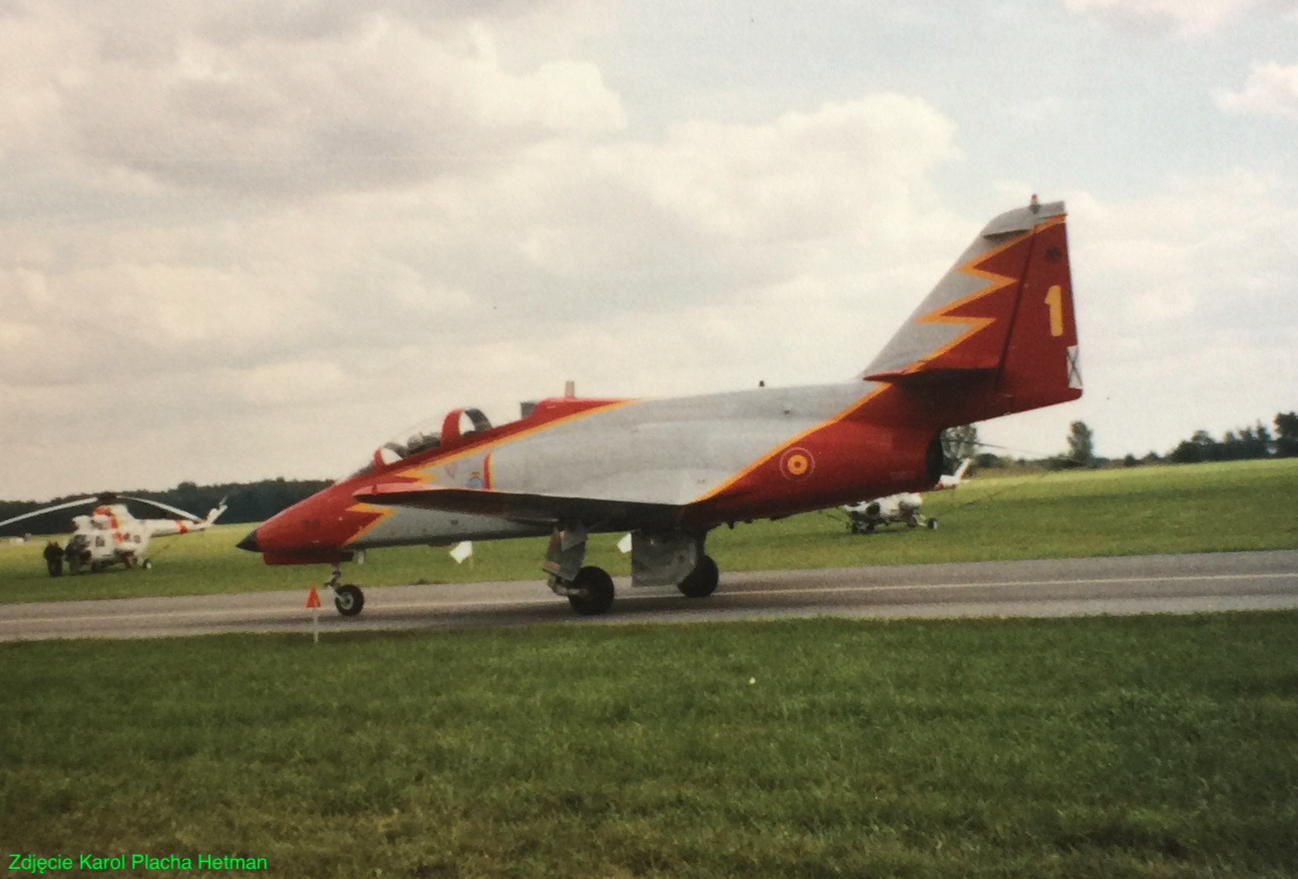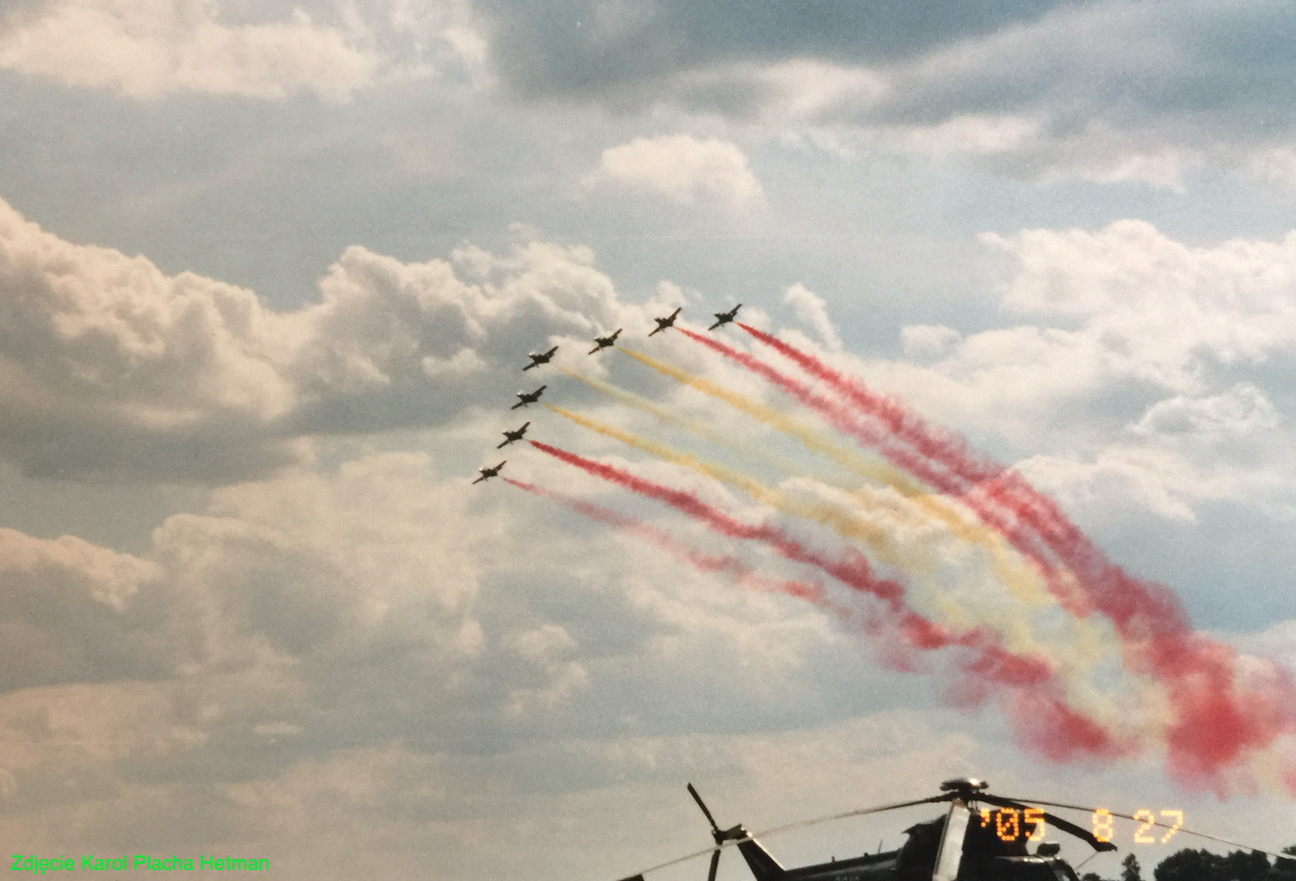Warszawa 2022-04-30
CASA C-101 Aviojet.
CASA C-101 Aviojet is a Spanish military training aircraft. The first flight took place on June 29, 1977. A total of 143 units were built. The plane was used by the air forces of Spain, Chile, Honduras and Jordan. In 2022, Spain withdrew Aviojet’s CASA C-101 aircraft from service.
The C-101 Aviojet aircraft was developed by the Spanish company Construcciones Aeronáuticas S.A., better known as CASA. CASA was founded on March 3, 1923. Since 2000, the company has been part of the European consortium Airbus Group and employs 12,700 employees. The company’s annual revenues amount to EUR 4.6 billion. Currently, the company mainly produces transport aircraft, including the well-known CASA C-295 M military transport aircraft in Poland.
CASA C-101 Aviojet planes were part of the equipment of the Patrulla Aguila military aerobatic team, which had already presented itself in Poland several times. For the first time during the Air Show Radom 2005.
Construcciones Aeronáuticas S.A. was founded in 1923 in Seville by José Ortiz de Echagüe. The goal was to produce aircraft for the army. Spain bought a license to produce the French Breguet 19 aircraft, well known in Poland. It was the first aircraft produced in Spain. Until 1970, only aircraft were produced under license. These included American Northrop F-5 Freedom Fighter aircraft and Germanic Bölkow Bo 105 helicopters. CASA also serviced other aircraft used by the military, for example McDonnell Douglas F-4 Phantom II heavy combat aircraft. In 1972, CASA was merged with the Hispano Aviación S.A. factory, and in 1973, with Empresa Nacional de Motores de Aviación, which dealt with aircraft engines.
Work on the CASA C-101 Aviojet aircraft began in 1973, based on an initial order issued by the military. The army intended to withdraw the used Hispano HA-200 Saeta jet aircraft from 1955 from service. Spanish engineers used the help of designers from Northrop. In 1975, a mock-up and documentation for the prototype were ready. The designers decided to build a chamber in the hull for weapons or reconnaissance equipment, which is rare in this type of structures.
An American twin-flow turbojet engine was also used as the powerplant. These types of engines have a larger diameter than single-flow designs, which results in a larger hull cross-section and a lower maximum speed, but they provide lower fuel consumption and a much longer range.Pierwszy lot został wykonany w dniu 29 czerwca 1977 roku, jednak testy rozpoczęto dopiero w dniu 17 kwietnia 1978 roku. Zbudowano 4 prototypy. W pracach nad prototypem pracowały Hiszpańskie siły powietrzne oraz Hiszpańskie lotnictwo marynarki wojennej. Pierwsze zamówienie wynosiło 60 samolotów. Pierwsze 4 samoloty dostarczono do akademii lotniczej; „Academia General del Aire”. Kolejne samoloty otrzymały docelowe wyposażenie i mogły pełnić rolę lekkich maszyn szturmowych. Samoloty zostały zamówione przez Chile, Honduras i Jordanie.
In 1983, an attack version of the C-101CC-02 aircraft was developed, which was devoid of training features; doubled controls, emergency simulator. These planes were ordered by Chile. Serial copies were assembled in Chile at the ENAER factory. There, the aircraft were designated A-36 Halcon. Jordan ordered 16 C-101CC-04 attack aircraft. In 1985, the last version was developed, designated C-101DD. The plane received better avionics and the ability to be armed with AGM-65 Maverick air-to-ground missiles. However, no orders have been received for this version.
In 2022, the Spanish Air Force ended the operation of CASA C-101 aircraft. During the training, CASA C-101 aircraft were replaced by Pilatus PC-21 turboprop aircraft. Spain operated 88 C-101 aircraft, Chile had 35 aircraft, Honduras had 4 aircraft, and Jordan had 16 aircraft. A total of 143 pieces. According to other data, a total of 166 aircraft were built.
Patrulla Águila aerobatic team.
Patrulla Águila was a Spanish military aerobatic team. The band debuted on June 14, 1985. At the beginning, it had 5 planes. The band gave its first foreign show on July 16, 1986, in Koksijde, Belgium. The performance was successful and resulted in the addition of a sixth plane for the soloist. In 1988, the team was expanded to 7 aircraft and with this composition the team flew to Radom in 2005. The group gave over 400 shows in Poland and abroad. The band Patrulla Aquila performed; Italy, France, Belgium, Israel, Malta, Slovakia, UK, Poland. The band’s performance could be divided into several parts. First, the machines start in relatively tight formations. They always check the weather conditions and arrange the "furniture" and only then move on to the actual shows. There are flights in various tight formations, with various maneuvers. Then there is a solo or couple part with spectacular razor blade passes. At the end, the formation reassembles. The team, flying in formation, performs a farewell flight, highlighted by smoke in the colors of the national colors, i.e. red and yellow. It was the only team in the world to demonstrate yellow smoke. In perfect weather conditions, the formation lands in groups. The show lasted about 15-20 minutes. The Spanish always record their flights, as souvenirs and for training purposes. In 2005, the team consisted of 12 pilots, 7 of whom are active and the remaining 5 are reserves and perform maintenance and insurance functions. All the pilots on the team were volunteers. They serve as instructors in the army, have at least 2,000 hours of flight experience and have served in combat divisions. In 2022, the team was disbanded due to the end of operation of the C-101 aircraft.
C-101 design.
The C-101 is an all-metal low-wing aircraft, built in a classic layout, powered by one engine. A straight wing was used. Tandem cabin layout.
Data T-T CASA C-101 Aviojet:
Wingspan 10.60 m (34 ft 9 in). Length 12.25 m (41 ft 0 in). Height 4.25 m (13 ft 11 in). Supporting area 20 m2 (220 sq ft). Leaf profile thickness 15%. Leaf profile type NorCasa 15. Empty weight 3,800 kg. Take-off weight 5,600 kg. Practical ceiling 12,495 m. Range with additional tanks 4,000 km. Maximum unarmed range with a 30-minute reserve of 2,000 km (1,200 mi, 1,100 nmi). Lo-lo-lo combat range 519 km (322 mi, 280 nmi). Top speed 769 km/h (478 mph, 415 kn). Cruising speed 656 km/h (408 mph, 354 kn). Minimum flight speed 213 km/h (132 mph; 115 kn). Touchdown speed 176 km/h (109 mph; 95 kn). Run-up 560 m (1,840 ft). Landing distance 800 m (2,600 ft).
Drive: one Garrett TFE731-2-2J engine, 15.8 kN thrust. Subsequent versions used the Honeywell TFE731-5-1J turbofan engine, with a thrust of 19.13 kN (4,300 lbf). The engines could be modernized to achieve a thrust of 20.91 kN (4,700 lbf) in the event of armed conflict.
Armament: 1 × 30 mm DEFA cannon, or 2x 12.7 mm (0.5") M3 machine gun. 6 weapon mounting points under the wings. Armament load up to 2,220 kg.
Written by Karol Placha Hetman


